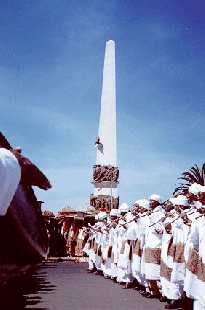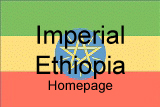There are several important monuments from the Imperial era which have survived the revolution of 1974. Many that were linked directly to Emperor Haile Selassie and his immediate family however were distroyed by the Dergue and have not survived. Pictures and discriptions have been included where possible.

Meyazia 27 Square (Arat Kilo)
Meyazia 27 Square is the official name of what is popularly known as Arat Kilo, a name that applies both to the square and the surrounding district of the city of Addis Ababa. The monument at the heart of the Square commemorates the victory over the fascist Italian invaders, and the struggle that preceded it (Meyazia 27 on the Ethiopian Calender, May 5th on the Gregorian Calender, is both the day that Addis Ababa was occupied by the Fascists, as well as the day that Emperor Haile Selassie returned to his capital in triumph exactly 5 years later). The original monument includes a relief of the Emperor Haile Selassie holding the national flag, which was altered during the reign of the Dergue regime into a representation of a guerrilla fighter holding the national flag. The EPRDF regime that deposed the Dergue restored the Emperor's face to the monument. The central obelisk, topped by a Lion of Judah, actually predates the fascist occupation, and the surrounding circle of relief figures and monumental panels was added after the war. The Arat Kilo monument stands at the heart of Addis Ababa's government district, and in front of the Ministry of Education building (not shown here). Holy Trinity Cathedral (whose dome can be seen in the background) and the Parliament building are nearby, as are the present office of the Prime Minister and the Imperial Palace. Also nearby are the Science College, the Holy Trinity Theological college, Emperor Menelik II High School and the Berhan Ena Selam Printing Press. Foriegn Heads of State customarily lay a wreath at this monument during state visits. This square was the focus of Victory Day celebrations held on May 5th (Meyazia 27) every year when the Emperor would lay a wreath here following his attendence at Mass at Meskia Hazunan Medhane Alem Church (Church of the Savior of the World, Consoler of the Grieved). The Dergue regime changed the date of Victory Day to the day that General Cunningham and his British, South African and Nigerian Troops actually entered the city. The post Dergue government in Ethiopia has restored Victory Day to it's original date.

Yekatit 12 Martyrs Square (Sidist Kilo)
The Yekatit 12 Square (Sidist Kilo) monument stands in tribute to the thousands of innocent martyrs butchered by the Fascist Italian Occupiers on that date in in the Ethiopian Calender year of 1929 (1936 Gregorian Calender). The massacre took place at the order of the Italian Vice-Roy Marshal Grazziani in response to an assasination attempt against him carried out by two pro-Ethiopia Eritreans. The monument is shown here during a religious procession of priests of the Orthodox Church, probably at Timkat (Epiphany). Wreaths were laid here by the Emperor to commemorate the massacre every year. Col. Mengistu Haile Mariam continued this practice during his rule, but for a time after the fall of the Dergue regime, only the Mayor of Addis carried out this practice. Recently, the President of the Federal Republic has taken over this task. The monument is in the form of a white obelisk with black bas reliefs of scenes of the massacre as well as scenes of the Imperial funeral accorded to the remains of the victims in the presence of the Emperor following the liberation around it. A Lion of Judah also decorates the face of the obelisk. Even though the image of the Lion of Judah and the Emperor Haile Selassie were removed from all over the city during the reign of the Dergue, they suprisingly did not touch this monument. The monument stands in the Sidist Kilo square infront of the Yekatit 12 Hospital (formerly Emperor Haile Selassie Hospital and known before that as the Beite Saida Hospital). Also facing the square are the southern gates of the Guenete Leul Palace, which today is the main campus of the Addis Ababa University (formerly Haile Selassie I University). Another major attraction adjoining the square is the old Imperial Lion Zoo, where many of the old Imperial lions and their decendents live. The Churches of Menbere Leul Kidus Markos (Altar of Princes St. Marks Church) and the Meskia Hazunan Medhane Alem are both nearby, as are the former palaces of the Crown Prince (later the Political Cadre's College during the Dergue Era), the Duke of Harrar (later the Headquarters of the Womens wing of the Workers Party of Ethiopia), and Princess Tenagnework (later the headquarters of the Ethiopian Navy), as well as the American and Greek Embassies.

Menelik II Square
In Menelik II Square stands the impossing equestrian statue of Emperor Menelik II, the victor of Adowa. The statue was erected by Emperor Haile Selassie and dedicated on the day before his coronation in 1930, in memory of his great predicessor. The square is located outside the main gates of St. George Cathedral (Genete Tsige Menagesha Kidus Giorgis), and is close to City Hall. The distance markers on all the highways in Ethiopia mark the distance to their location from the base of the statue of Emperor Menelik II in this Square. Every year, on the anniversary of the victory of the Battle of Adowa, the Emperor would lay a wreath at this statue after attending mass at St. George Cathedral (the victory had occured on St. George's Day). Col. Mengistu continued laying a wreath here on the anniversary, but did not attend the church services as his regime was Marxist.

A view of the Square with the dome of St. George in the background

The Lion of Judah Monument
The Lion of Judah Monument stands in the square in front of Addis Ababa's train station. The golden colored statue of the Lion of Judah in it's complete glory stands on a black granite pedestal which is decorated with relief portraits of Emperors Menelik II and Haile Selassie I, and Empress Zewditu, as well as Ras Makonnen. It marks the foot of the city's widest and avenue, Churchill Road which has the impressive Addis Ababa City Hall at it's other end. The Lion of Judah statue has a very interesting history. Erected in 1930 just before Emperor Haile Selassie's coronation, it was looted by the Italian occupiers in 1935 and taken to Rome, where it was erected next to the Vittorio Emanuelle Monument. During the 4th anniversary celebrations of the proclomation of the Itlian Empire, Adolf Hitler chose to visit Rome, and attended the celebratory parades along side the Fascist Dictator Musollini and King Victor Emanuelle III. In the parade were numerous subjects of Italy's African Empire, including a young Eritrean named Zerai Deres. Zerai Deres was marching with other parade members carrying a ceremonial sword with which to salute the King, the Fuhrer, and el Duce, at the grandstand. As the parade marched past the Vittorio Emauelle monument, Zerai looked up and saw to his shock, the golden Lion of Judah, the symbol of the ancient monarchy to which his ancestors had long owed aliegence, erected as war booty in the heart of Rome. It was too much for him to bear, and he promptly drew his sword and with tears of anger running down his face he fell on the first Italian officer he could find. He killed and wounded numerous Italian military officers before he was killed. Zerai Deres is lionized to this day as a brave Ethiopian patriot. The monument remained in Rome for several decades, and was finally returned to Addis Ababa after long negotiations in the 1960's. When it was re-erected in it's square the day it arrived, the Emperor was present in military uniform to salute, and to pay tribute to Zerai Deres. Following the revolution in 1974, the Dergue regime decided to remove the statue once more as it was a monarchist symbol. However, the elderly war veterans association members appealed to the Dergue to consider the memory of Zerai Deres and his sacrifice that was inspired by this very symbol. This act saved the statue and it stood it all it's Imperial glory right through the Dergue era, and continues to stand today.

Abune Petros Memorial
Just West of Addis Ababa's impressive City Hall, down the hill on the main road to the Merkato district is Abune Petros Square with it's imposing statue. Abune Petros, the Ethiopian Orthodox Bishop of Wello who was executed by the Italians at the edge of this very square. Abune Petros was one of the four first native Ethiopians who were anointed as bishops by the Coptic Patriarch of Alexandria to serve under the Coptic born Archbishop Abune Kerllos of Ethiopia in 1932. Abune Petros was given the province of Wello as his diocese. In 1936, the Fascist armies of Benito Mussolini occupied much of Ethiopia, and Abune Petros traveled to the northern Shewan district of Menz to join the sons of Ras Kassa, Dejazmatches Wondwossen, Abera and Asfa Wossen Kassa and other resistance leaders to plan an attack on the Italians to drive them out of Addis Ababa. The attack failed in 1937, and the Bishop was captured. Defiantly refusing to submit to Italian rule, he was condemned to death. Shortly before his execution Abune Petros Bishop of Wello, dressed in his clerical robes, held up his hand cross and pronounced his anathema on the people and on the very earth of Ethiopia itself, if they were ever to submit to the invader. He was then shot to death in front of a horrified audience. Emperor Haile Selassie had the statue erected in the memory of this great Bishop upon his restoration to the throne. The spot of his execution on the western edge of this sqare is also marked by a memorial slab. Sadly, during the brutal rule of the Dergue regime, the bodies of many victims of the "Red Terror" were displayed in this square.
 Imperial Monuments of Ethiopia
Imperial Monuments of Ethiopia


 Imperial Monuments of Ethiopia
Imperial Monuments of Ethiopia

